Accounting Fundamentals Assessment 1 - Eccles plc Financial Analysis
VerifiedAdded on 2023/01/05
|10
|2158
|86
Homework Assignment
AI Summary
This document presents a comprehensive solution to an accounting fundamentals assessment, focusing on the financial analysis of Eccles plc and Chocco Plc. It includes the preparation of an income statement and a statement of financial position for Eccles plc, along with detailed working notes. The solution further delves into ratio analysis, covering liquidity, solvency, profitability, efficiency, coverage, and market prospect ratios, providing calculations and interpretations for both Eccles plc and Chocco Plc. The analysis offers insights into the financial performance and position of Chocco Plc, highlighting key areas like profitability, debt management, and overall financial health. The document also addresses the balancing of the statement of financial position and explains the underlying accounting principles. Finally, the document provides comments on the financial performance and position of Chocco Plc, analyzing financial ratios and the overall financial health of the company.
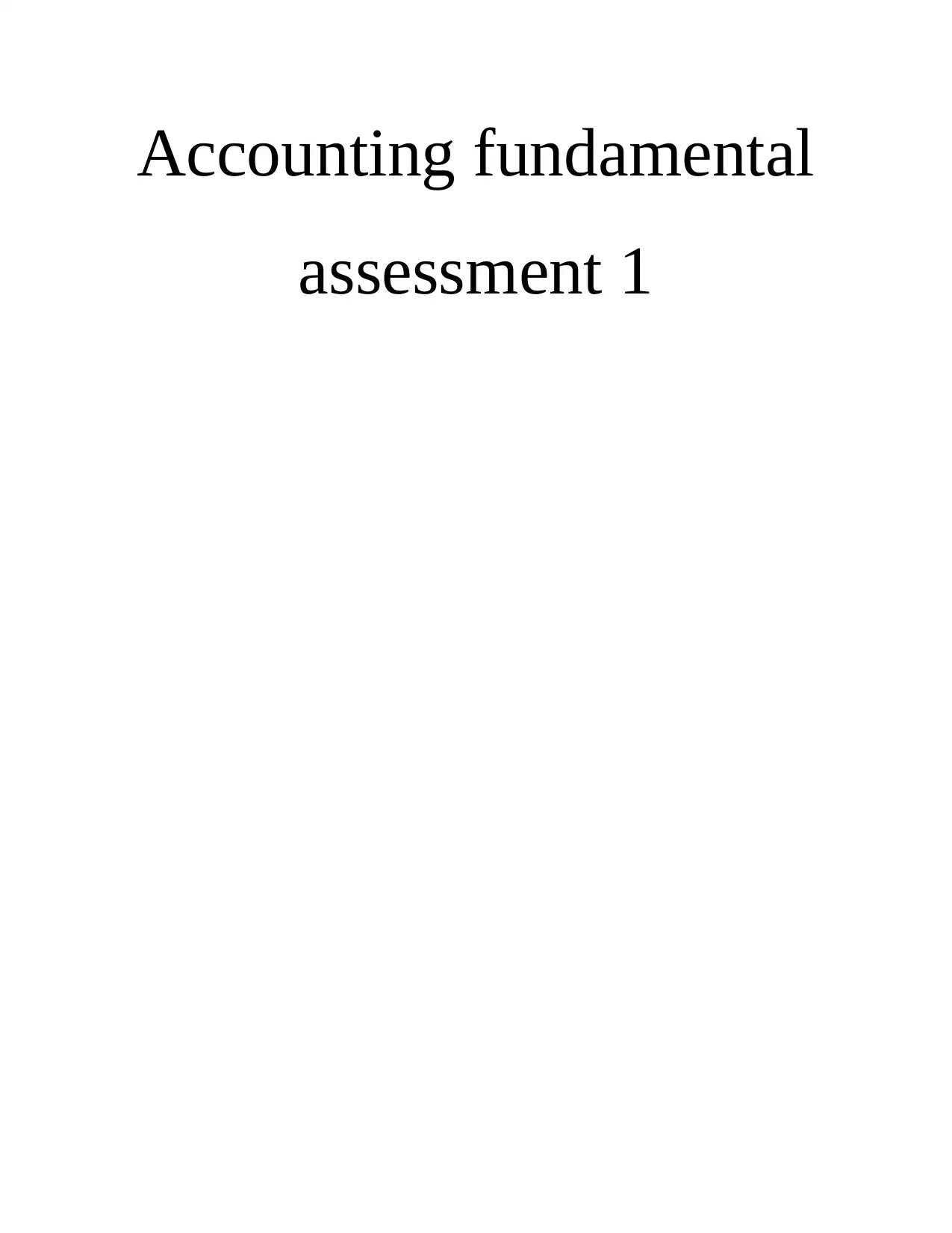
Accounting fundamental
assessment 1
assessment 1
Paraphrase This Document
Need a fresh take? Get an instant paraphrase of this document with our AI Paraphraser
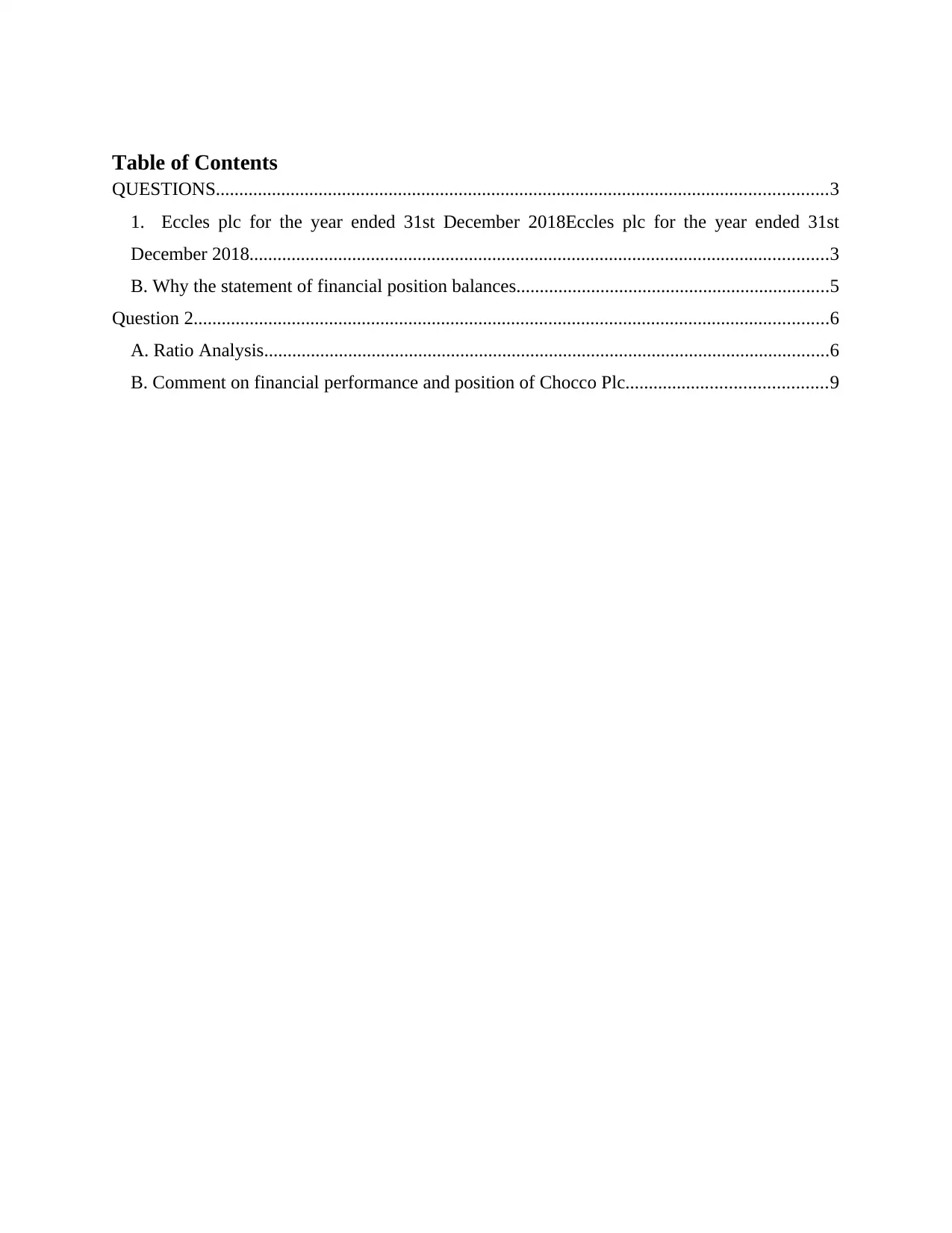
Table of Contents
QUESTIONS...................................................................................................................................3
1. Eccles plc for the year ended 31st December 2018Eccles plc for the year ended 31st
December 2018............................................................................................................................3
B. Why the statement of financial position balances...................................................................5
Question 2........................................................................................................................................6
A. Ratio Analysis.........................................................................................................................6
B. Comment on financial performance and position of Chocco Plc...........................................9
QUESTIONS...................................................................................................................................3
1. Eccles plc for the year ended 31st December 2018Eccles plc for the year ended 31st
December 2018............................................................................................................................3
B. Why the statement of financial position balances...................................................................5
Question 2........................................................................................................................................6
A. Ratio Analysis.........................................................................................................................6
B. Comment on financial performance and position of Chocco Plc...........................................9

QUESTIONS
1. Eccles plc for the year ended 31st December 2018Eccles plc for the year ended 31st
December 2018
A). Income statement for the year ended 31st December 2019 for Eccles plc and a statement of
financial position as at that date.
Income statement
Particulars Amount
Revenue (amount of goods or service sold for period) 827630
Cost of sales 578650
Gross profit 248980
Distribution cost 31000
Administration cost 85000
Other income 0
Operating profit 135980
Income from investment 0
Finance cost 2000
Profit before tax 130980
Taxation 68000
Net profit 62980
Statement of financial position
1. Eccles plc for the year ended 31st December 2018Eccles plc for the year ended 31st
December 2018
A). Income statement for the year ended 31st December 2019 for Eccles plc and a statement of
financial position as at that date.
Income statement
Particulars Amount
Revenue (amount of goods or service sold for period) 827630
Cost of sales 578650
Gross profit 248980
Distribution cost 31000
Administration cost 85000
Other income 0
Operating profit 135980
Income from investment 0
Finance cost 2000
Profit before tax 130980
Taxation 68000
Net profit 62980
Statement of financial position
⊘ This is a preview!⊘
Do you want full access?
Subscribe today to unlock all pages.

Trusted by 1+ million students worldwide
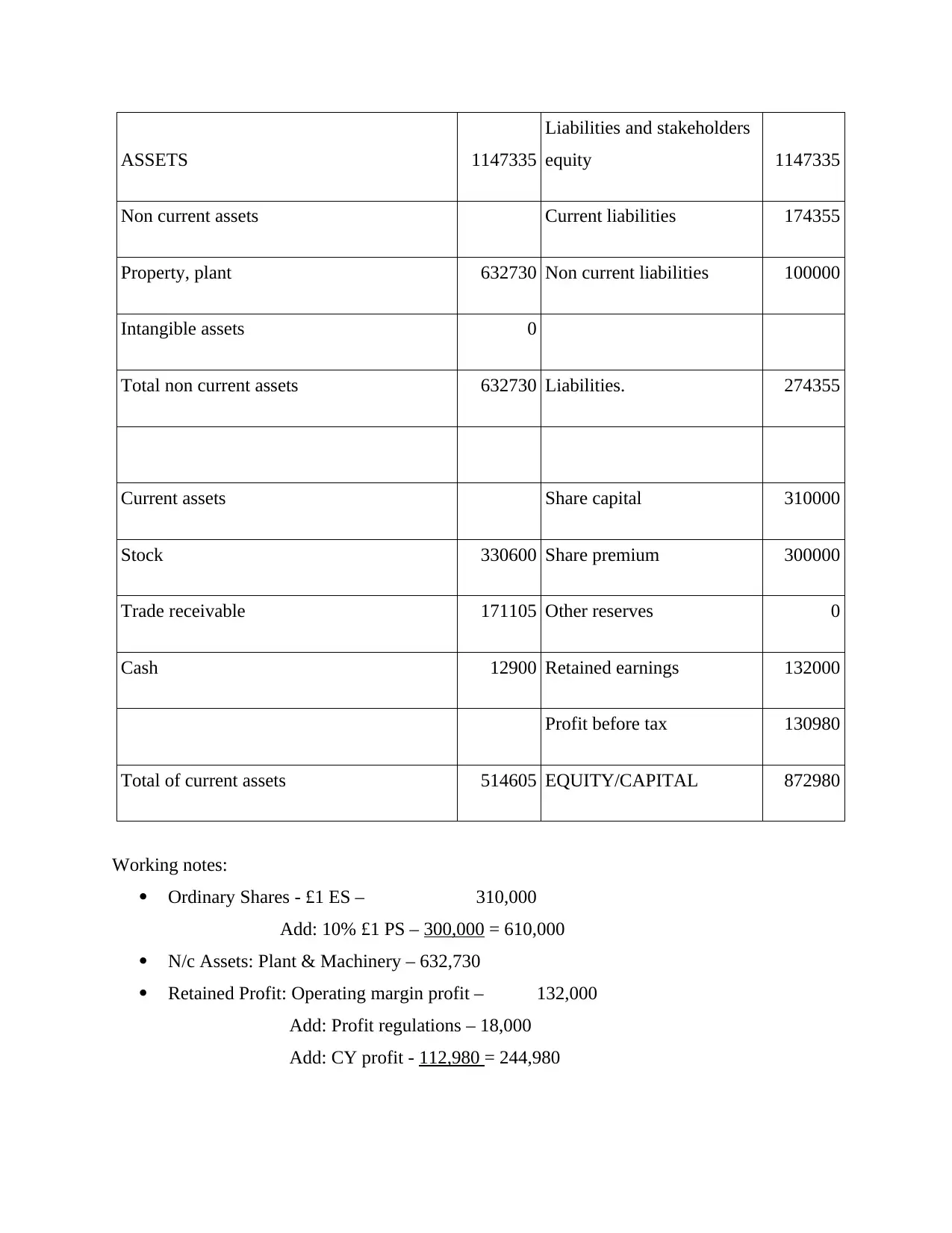
ASSETS 1147335
Liabilities and stakeholders
equity 1147335
Non current assets Current liabilities 174355
Property, plant 632730 Non current liabilities 100000
Intangible assets 0
Total non current assets 632730 Liabilities. 274355
Current assets Share capital 310000
Stock 330600 Share premium 300000
Trade receivable 171105 Other reserves 0
Cash 12900 Retained earnings 132000
Profit before tax 130980
Total of current assets 514605 EQUITY/CAPITAL 872980
Working notes:
Ordinary Shares - £1 ES – 310,000
Add: 10% £1 PS – 300,000 = 610,000
N/c Assets: Plant & Machinery – 632,730
Retained Profit: Operating margin profit – 132,000
Add: Profit regulations – 18,000
Add: CY profit - 112,980 = 244,980
Liabilities and stakeholders
equity 1147335
Non current assets Current liabilities 174355
Property, plant 632730 Non current liabilities 100000
Intangible assets 0
Total non current assets 632730 Liabilities. 274355
Current assets Share capital 310000
Stock 330600 Share premium 300000
Trade receivable 171105 Other reserves 0
Cash 12900 Retained earnings 132000
Profit before tax 130980
Total of current assets 514605 EQUITY/CAPITAL 872980
Working notes:
Ordinary Shares - £1 ES – 310,000
Add: 10% £1 PS – 300,000 = 610,000
N/c Assets: Plant & Machinery – 632,730
Retained Profit: Operating margin profit – 132,000
Add: Profit regulations – 18,000
Add: CY profit - 112,980 = 244,980
Paraphrase This Document
Need a fresh take? Get an instant paraphrase of this document with our AI Paraphraser
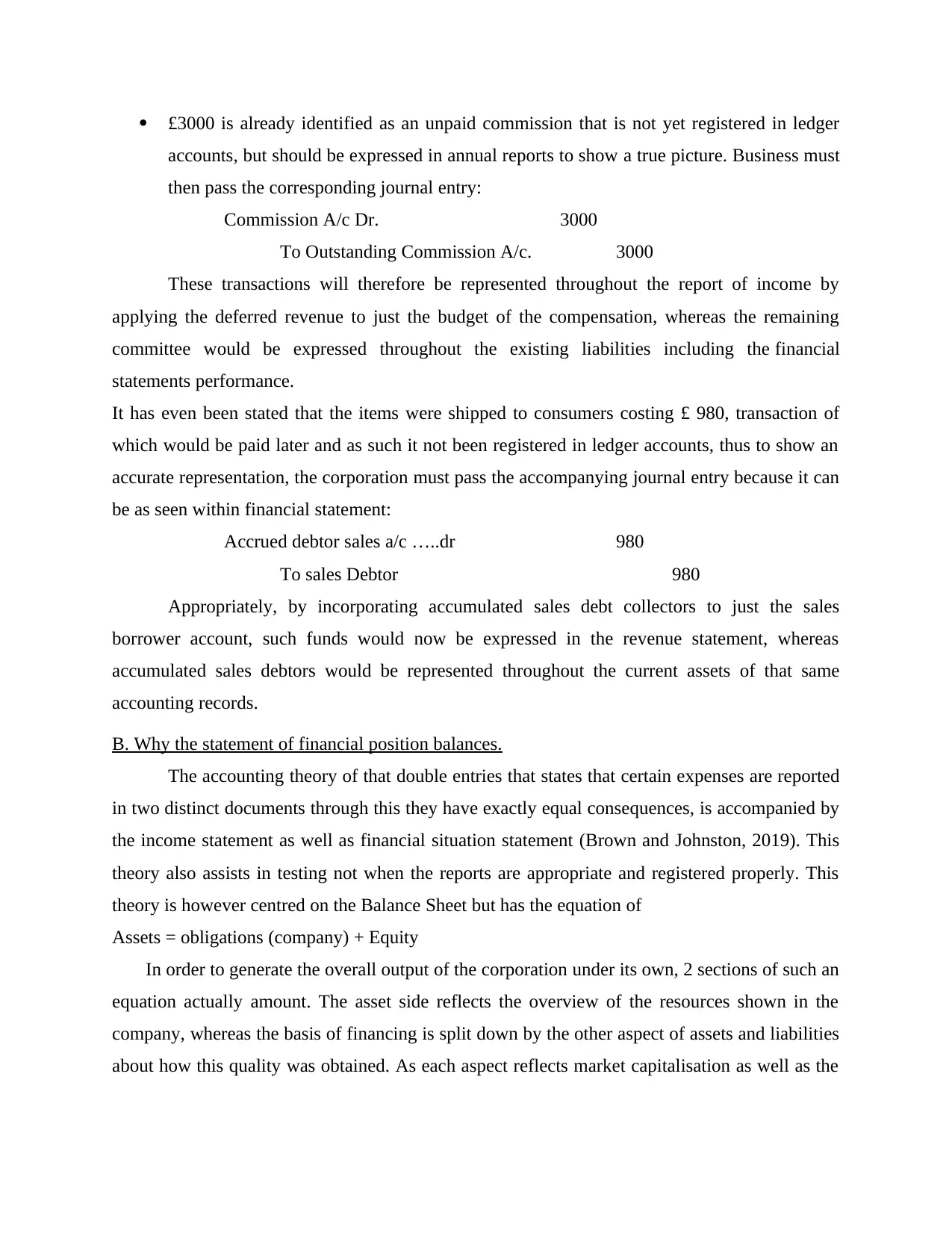
£3000 is already identified as an unpaid commission that is not yet registered in ledger
accounts, but should be expressed in annual reports to show a true picture. Business must
then pass the corresponding journal entry:
Commission A/c Dr. 3000
To Outstanding Commission A/c. 3000
These transactions will therefore be represented throughout the report of income by
applying the deferred revenue to just the budget of the compensation, whereas the remaining
committee would be expressed throughout the existing liabilities including the financial
statements performance.
It has even been stated that the items were shipped to consumers costing £ 980, transaction of
which would be paid later and as such it not been registered in ledger accounts, thus to show an
accurate representation, the corporation must pass the accompanying journal entry because it can
be as seen within financial statement:
Accrued debtor sales a/c …..dr 980
To sales Debtor 980
Appropriately, by incorporating accumulated sales debt collectors to just the sales
borrower account, such funds would now be expressed in the revenue statement, whereas
accumulated sales debtors would be represented throughout the current assets of that same
accounting records.
B. Why the statement of financial position balances.
The accounting theory of that double entries that states that certain expenses are reported
in two distinct documents through this they have exactly equal consequences, is accompanied by
the income statement as well as financial situation statement (Brown and Johnston, 2019). This
theory also assists in testing not when the reports are appropriate and registered properly. This
theory is however centred on the Balance Sheet but has the equation of
Assets = obligations (company) + Equity
In order to generate the overall output of the corporation under its own, 2 sections of such an
equation actually amount. The asset side reflects the overview of the resources shown in the
company, whereas the basis of financing is split down by the other aspect of assets and liabilities
about how this quality was obtained. As each aspect reflects market capitalisation as well as the
accounts, but should be expressed in annual reports to show a true picture. Business must
then pass the corresponding journal entry:
Commission A/c Dr. 3000
To Outstanding Commission A/c. 3000
These transactions will therefore be represented throughout the report of income by
applying the deferred revenue to just the budget of the compensation, whereas the remaining
committee would be expressed throughout the existing liabilities including the financial
statements performance.
It has even been stated that the items were shipped to consumers costing £ 980, transaction of
which would be paid later and as such it not been registered in ledger accounts, thus to show an
accurate representation, the corporation must pass the accompanying journal entry because it can
be as seen within financial statement:
Accrued debtor sales a/c …..dr 980
To sales Debtor 980
Appropriately, by incorporating accumulated sales debt collectors to just the sales
borrower account, such funds would now be expressed in the revenue statement, whereas
accumulated sales debtors would be represented throughout the current assets of that same
accounting records.
B. Why the statement of financial position balances.
The accounting theory of that double entries that states that certain expenses are reported
in two distinct documents through this they have exactly equal consequences, is accompanied by
the income statement as well as financial situation statement (Brown and Johnston, 2019). This
theory also assists in testing not when the reports are appropriate and registered properly. This
theory is however centred on the Balance Sheet but has the equation of
Assets = obligations (company) + Equity
In order to generate the overall output of the corporation under its own, 2 sections of such an
equation actually amount. The asset side reflects the overview of the resources shown in the
company, whereas the basis of financing is split down by the other aspect of assets and liabilities
about how this quality was obtained. As each aspect reflects market capitalisation as well as the
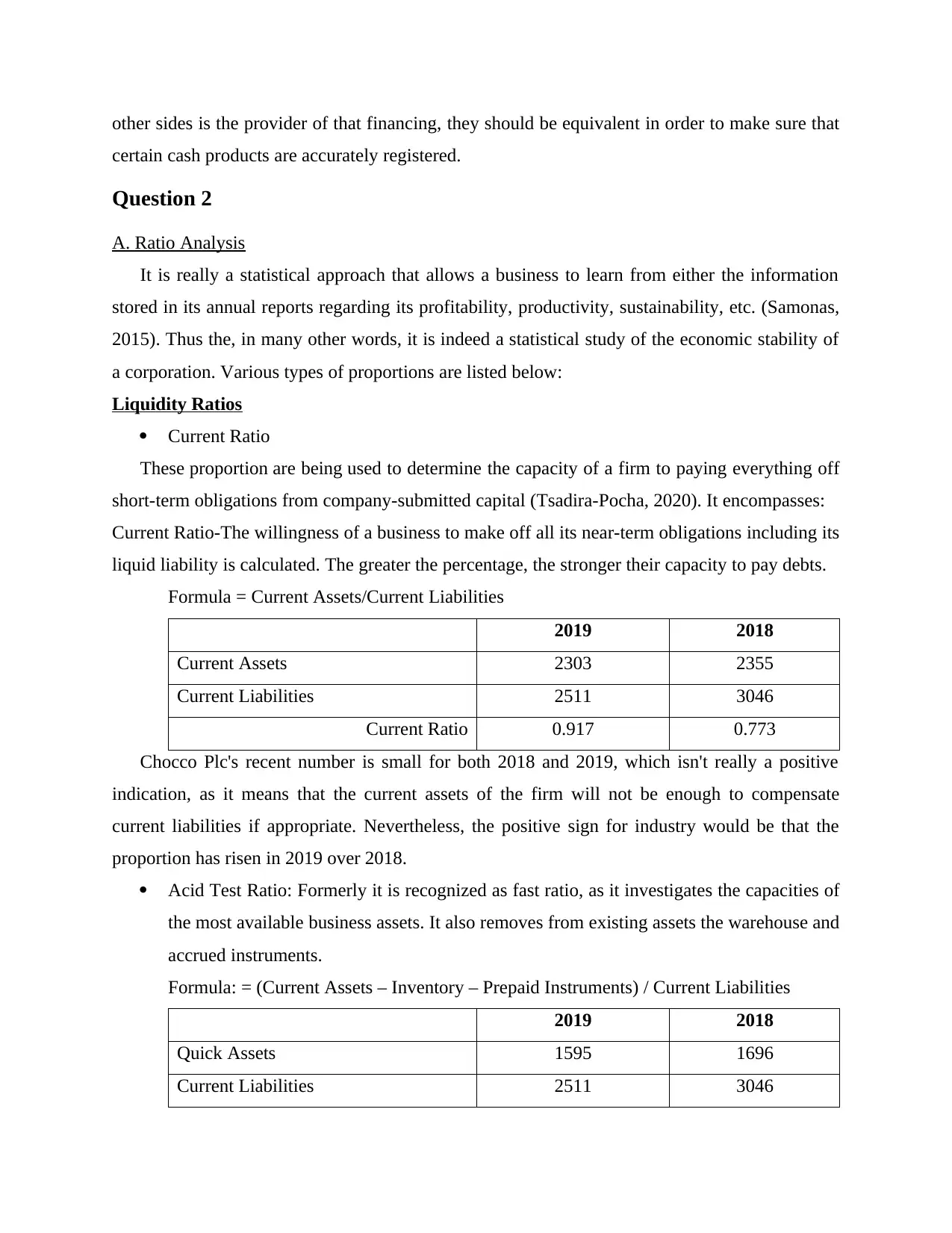
other sides is the provider of that financing, they should be equivalent in order to make sure that
certain cash products are accurately registered.
Question 2
A. Ratio Analysis
It is really a statistical approach that allows a business to learn from either the information
stored in its annual reports regarding its profitability, productivity, sustainability, etc. (Samonas,
2015). Thus the, in many other words, it is indeed a statistical study of the economic stability of
a corporation. Various types of proportions are listed below:
Liquidity Ratios
Current Ratio
These proportion are being used to determine the capacity of a firm to paying everything off
short-term obligations from company-submitted capital (Tsadira-Pocha, 2020). It encompasses:
Current Ratio-The willingness of a business to make off all its near-term obligations including its
liquid liability is calculated. The greater the percentage, the stronger their capacity to pay debts.
Formula = Current Assets/Current Liabilities
2019 2018
Current Assets 2303 2355
Current Liabilities 2511 3046
Current Ratio 0.917 0.773
Chocco Plc's recent number is small for both 2018 and 2019, which isn't really a positive
indication, as it means that the current assets of the firm will not be enough to compensate
current liabilities if appropriate. Nevertheless, the positive sign for industry would be that the
proportion has risen in 2019 over 2018.
Acid Test Ratio: Formerly it is recognized as fast ratio, as it investigates the capacities of
the most available business assets. It also removes from existing assets the warehouse and
accrued instruments.
Formula: = (Current Assets – Inventory – Prepaid Instruments) / Current Liabilities
2019 2018
Quick Assets 1595 1696
Current Liabilities 2511 3046
certain cash products are accurately registered.
Question 2
A. Ratio Analysis
It is really a statistical approach that allows a business to learn from either the information
stored in its annual reports regarding its profitability, productivity, sustainability, etc. (Samonas,
2015). Thus the, in many other words, it is indeed a statistical study of the economic stability of
a corporation. Various types of proportions are listed below:
Liquidity Ratios
Current Ratio
These proportion are being used to determine the capacity of a firm to paying everything off
short-term obligations from company-submitted capital (Tsadira-Pocha, 2020). It encompasses:
Current Ratio-The willingness of a business to make off all its near-term obligations including its
liquid liability is calculated. The greater the percentage, the stronger their capacity to pay debts.
Formula = Current Assets/Current Liabilities
2019 2018
Current Assets 2303 2355
Current Liabilities 2511 3046
Current Ratio 0.917 0.773
Chocco Plc's recent number is small for both 2018 and 2019, which isn't really a positive
indication, as it means that the current assets of the firm will not be enough to compensate
current liabilities if appropriate. Nevertheless, the positive sign for industry would be that the
proportion has risen in 2019 over 2018.
Acid Test Ratio: Formerly it is recognized as fast ratio, as it investigates the capacities of
the most available business assets. It also removes from existing assets the warehouse and
accrued instruments.
Formula: = (Current Assets – Inventory – Prepaid Instruments) / Current Liabilities
2019 2018
Quick Assets 1595 1696
Current Liabilities 2511 3046
⊘ This is a preview!⊘
Do you want full access?
Subscribe today to unlock all pages.

Trusted by 1+ million students worldwide

Quick Ratio 0.635 0.557
Chocco Plc's acid test Ratio is lower than 1 that is not really a positive measure, since it
suggests that in the event of uncertainties, the company's quick reserves are insufficient to
compensate existing liabilities. In 2019, however, the proportion changed from 2018
onwards.
Solvency Ratios
These are also recognized as leverage proportion as well. These are being used to assess
the company's chances of long-term adequacy and willingness to fund itself (Brown and et.al.,
2016). It encompasses:
Debt-to-equity ratio: This ratio calculates the equity-funded amount of debt. The smaller the
proportion it is consider to be more effective
Formula: Total debt/total equity
2019 2018
Total liabilities 6828 7175
Total equity 3088 2912
Debt-to-equity Ratio 2.21 2.46
Greater leverage to equity ratios are not deemed well for the firm, as reported earlier. Chocco
Plc's debt equity ratio reveals the leverage is much more than double the corporation's
capital, which raises the risk of failure when the capital is insufficient to fund obligations if
appropriate.
Debt-to-asset Ratio
This proportion is used to analyses the debt of the business by calculating the amount of
loans funded by the company's assets (Rachlin, 2019).
Formula: Total debt/Total assets
2019 2018
Total liabilities 6828 7175
Total assets 9736 10087
Debt-to-asset Ratio 0.701 0.711
The amount of debt to assets greater than 1 is not deemed to be safe. Chocco plc's debt-to
- asset proportion is much less than, that means the borrowing is also not substantially financed
and against firm net income. In comparison, in 2019, the ratio increased from 2018.
Chocco Plc's acid test Ratio is lower than 1 that is not really a positive measure, since it
suggests that in the event of uncertainties, the company's quick reserves are insufficient to
compensate existing liabilities. In 2019, however, the proportion changed from 2018
onwards.
Solvency Ratios
These are also recognized as leverage proportion as well. These are being used to assess
the company's chances of long-term adequacy and willingness to fund itself (Brown and et.al.,
2016). It encompasses:
Debt-to-equity ratio: This ratio calculates the equity-funded amount of debt. The smaller the
proportion it is consider to be more effective
Formula: Total debt/total equity
2019 2018
Total liabilities 6828 7175
Total equity 3088 2912
Debt-to-equity Ratio 2.21 2.46
Greater leverage to equity ratios are not deemed well for the firm, as reported earlier. Chocco
Plc's debt equity ratio reveals the leverage is much more than double the corporation's
capital, which raises the risk of failure when the capital is insufficient to fund obligations if
appropriate.
Debt-to-asset Ratio
This proportion is used to analyses the debt of the business by calculating the amount of
loans funded by the company's assets (Rachlin, 2019).
Formula: Total debt/Total assets
2019 2018
Total liabilities 6828 7175
Total assets 9736 10087
Debt-to-asset Ratio 0.701 0.711
The amount of debt to assets greater than 1 is not deemed to be safe. Chocco plc's debt-to
- asset proportion is much less than, that means the borrowing is also not substantially financed
and against firm net income. In comparison, in 2019, the ratio increased from 2018.
Paraphrase This Document
Need a fresh take? Get an instant paraphrase of this document with our AI Paraphraser
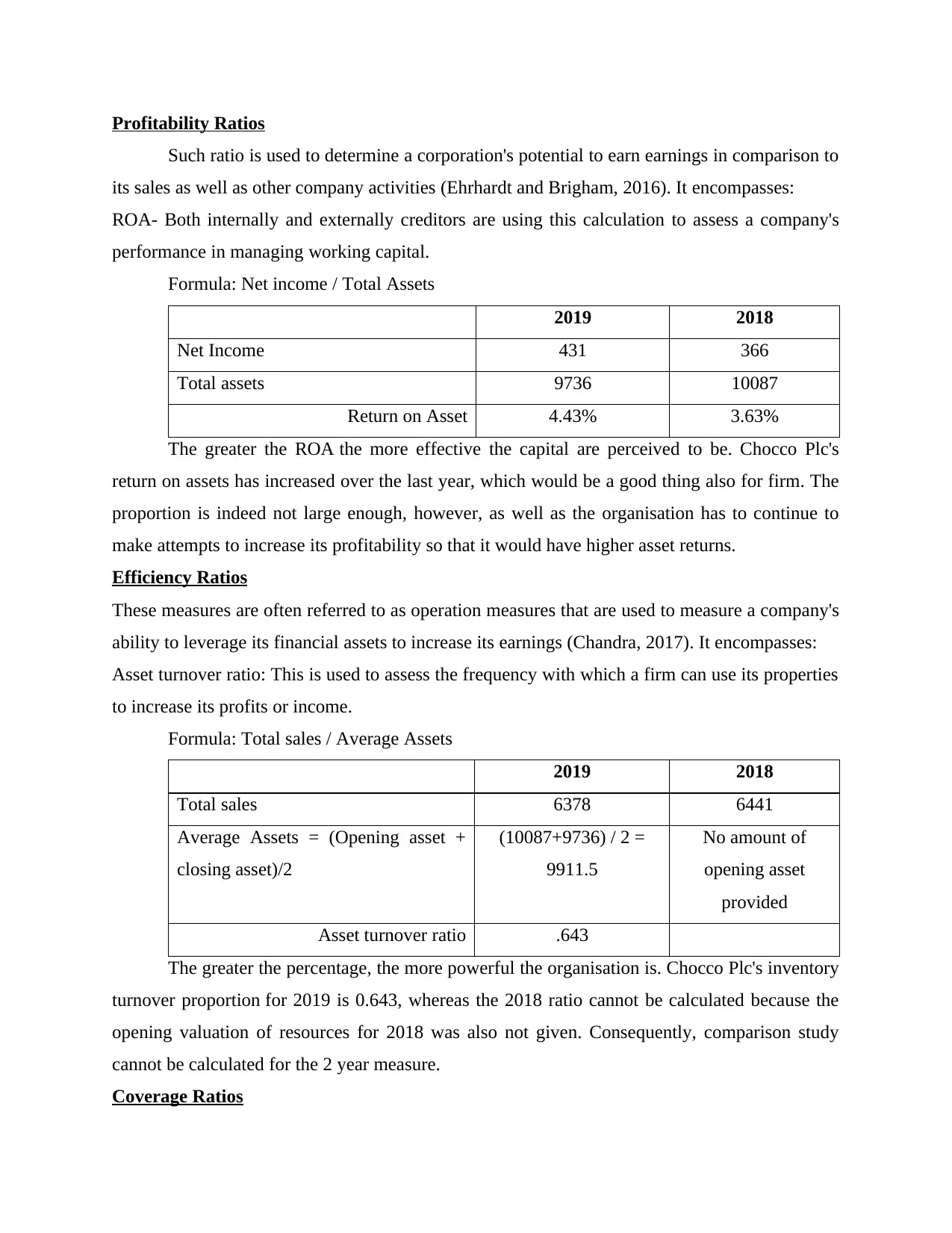
Profitability Ratios
Such ratio is used to determine a corporation's potential to earn earnings in comparison to
its sales as well as other company activities (Ehrhardt and Brigham, 2016). It encompasses:
ROA- Both internally and externally creditors are using this calculation to assess a company's
performance in managing working capital.
Formula: Net income / Total Assets
2019 2018
Net Income 431 366
Total assets 9736 10087
Return on Asset 4.43% 3.63%
The greater the ROA the more effective the capital are perceived to be. Chocco Plc's
return on assets has increased over the last year, which would be a good thing also for firm. The
proportion is indeed not large enough, however, as well as the organisation has to continue to
make attempts to increase its profitability so that it would have higher asset returns.
Efficiency Ratios
These measures are often referred to as operation measures that are used to measure a company's
ability to leverage its financial assets to increase its earnings (Chandra, 2017). It encompasses:
Asset turnover ratio: This is used to assess the frequency with which a firm can use its properties
to increase its profits or income.
Formula: Total sales / Average Assets
2019 2018
Total sales 6378 6441
Average Assets = (Opening asset +
closing asset)/2
(10087+9736) / 2 =
9911.5
No amount of
opening asset
provided
Asset turnover ratio .643
The greater the percentage, the more powerful the organisation is. Chocco Plc's inventory
turnover proportion for 2019 is 0.643, whereas the 2018 ratio cannot be calculated because the
opening valuation of resources for 2018 was also not given. Consequently, comparison study
cannot be calculated for the 2 year measure.
Coverage Ratios
Such ratio is used to determine a corporation's potential to earn earnings in comparison to
its sales as well as other company activities (Ehrhardt and Brigham, 2016). It encompasses:
ROA- Both internally and externally creditors are using this calculation to assess a company's
performance in managing working capital.
Formula: Net income / Total Assets
2019 2018
Net Income 431 366
Total assets 9736 10087
Return on Asset 4.43% 3.63%
The greater the ROA the more effective the capital are perceived to be. Chocco Plc's
return on assets has increased over the last year, which would be a good thing also for firm. The
proportion is indeed not large enough, however, as well as the organisation has to continue to
make attempts to increase its profitability so that it would have higher asset returns.
Efficiency Ratios
These measures are often referred to as operation measures that are used to measure a company's
ability to leverage its financial assets to increase its earnings (Chandra, 2017). It encompasses:
Asset turnover ratio: This is used to assess the frequency with which a firm can use its properties
to increase its profits or income.
Formula: Total sales / Average Assets
2019 2018
Total sales 6378 6441
Average Assets = (Opening asset +
closing asset)/2
(10087+9736) / 2 =
9911.5
No amount of
opening asset
provided
Asset turnover ratio .643
The greater the percentage, the more powerful the organisation is. Chocco Plc's inventory
turnover proportion for 2019 is 0.643, whereas the 2018 ratio cannot be calculated because the
opening valuation of resources for 2018 was also not given. Consequently, comparison study
cannot be calculated for the 2 year measure.
Coverage Ratios
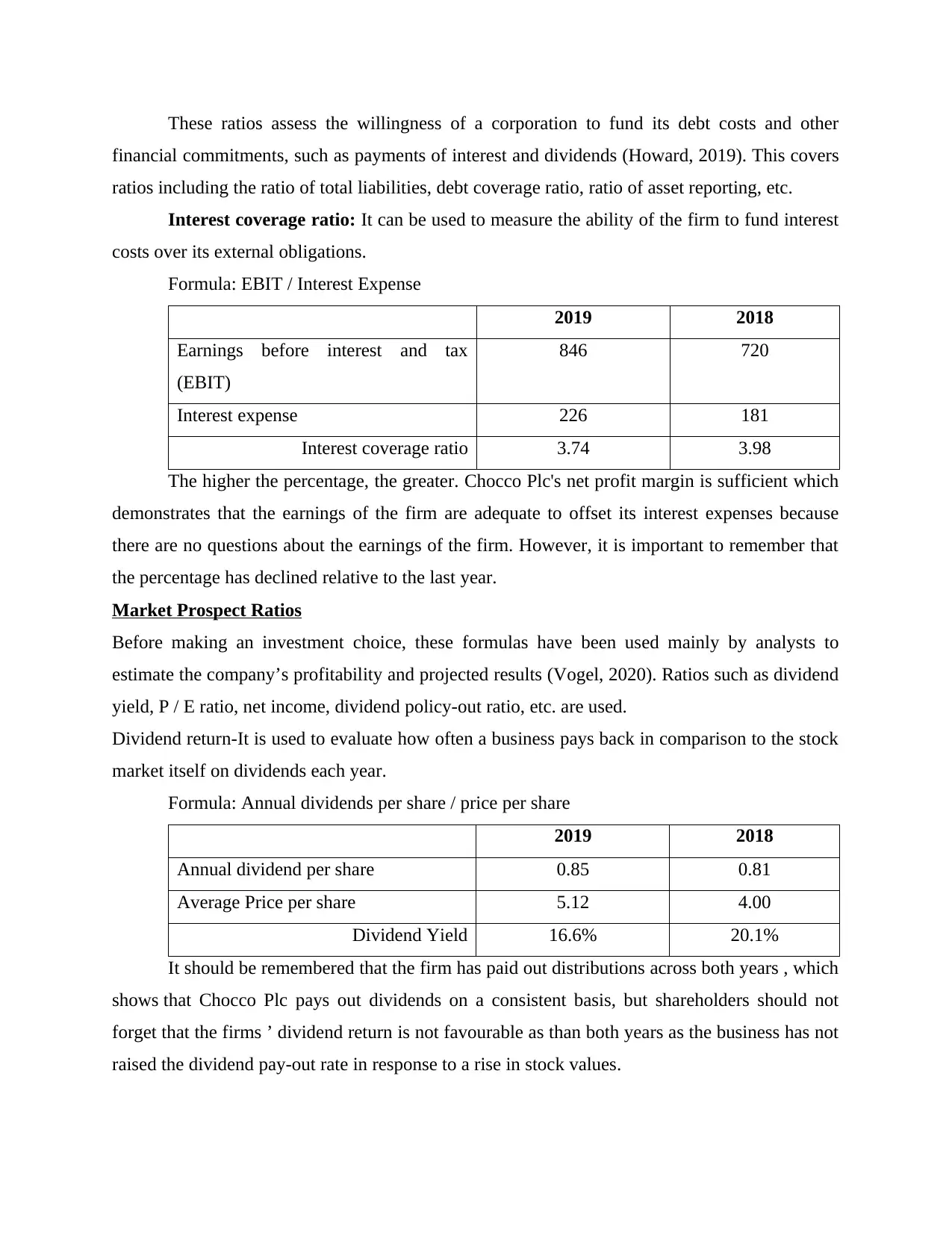
These ratios assess the willingness of a corporation to fund its debt costs and other
financial commitments, such as payments of interest and dividends (Howard, 2019). This covers
ratios including the ratio of total liabilities, debt coverage ratio, ratio of asset reporting, etc.
Interest coverage ratio: It can be used to measure the ability of the firm to fund interest
costs over its external obligations.
Formula: EBIT / Interest Expense
2019 2018
Earnings before interest and tax
(EBIT)
846 720
Interest expense 226 181
Interest coverage ratio 3.74 3.98
The higher the percentage, the greater. Chocco Plc's net profit margin is sufficient which
demonstrates that the earnings of the firm are adequate to offset its interest expenses because
there are no questions about the earnings of the firm. However, it is important to remember that
the percentage has declined relative to the last year.
Market Prospect Ratios
Before making an investment choice, these formulas have been used mainly by analysts to
estimate the company’s profitability and projected results (Vogel, 2020). Ratios such as dividend
yield, P / E ratio, net income, dividend policy-out ratio, etc. are used.
Dividend return-It is used to evaluate how often a business pays back in comparison to the stock
market itself on dividends each year.
Formula: Annual dividends per share / price per share
2019 2018
Annual dividend per share 0.85 0.81
Average Price per share 5.12 4.00
Dividend Yield 16.6% 20.1%
It should be remembered that the firm has paid out distributions across both years , which
shows that Chocco Plc pays out dividends on a consistent basis, but shareholders should not
forget that the firms ’ dividend return is not favourable as than both years as the business has not
raised the dividend pay-out rate in response to a rise in stock values.
financial commitments, such as payments of interest and dividends (Howard, 2019). This covers
ratios including the ratio of total liabilities, debt coverage ratio, ratio of asset reporting, etc.
Interest coverage ratio: It can be used to measure the ability of the firm to fund interest
costs over its external obligations.
Formula: EBIT / Interest Expense
2019 2018
Earnings before interest and tax
(EBIT)
846 720
Interest expense 226 181
Interest coverage ratio 3.74 3.98
The higher the percentage, the greater. Chocco Plc's net profit margin is sufficient which
demonstrates that the earnings of the firm are adequate to offset its interest expenses because
there are no questions about the earnings of the firm. However, it is important to remember that
the percentage has declined relative to the last year.
Market Prospect Ratios
Before making an investment choice, these formulas have been used mainly by analysts to
estimate the company’s profitability and projected results (Vogel, 2020). Ratios such as dividend
yield, P / E ratio, net income, dividend policy-out ratio, etc. are used.
Dividend return-It is used to evaluate how often a business pays back in comparison to the stock
market itself on dividends each year.
Formula: Annual dividends per share / price per share
2019 2018
Annual dividend per share 0.85 0.81
Average Price per share 5.12 4.00
Dividend Yield 16.6% 20.1%
It should be remembered that the firm has paid out distributions across both years , which
shows that Chocco Plc pays out dividends on a consistent basis, but shareholders should not
forget that the firms ’ dividend return is not favourable as than both years as the business has not
raised the dividend pay-out rate in response to a rise in stock values.
⊘ This is a preview!⊘
Do you want full access?
Subscribe today to unlock all pages.

Trusted by 1+ million students worldwide
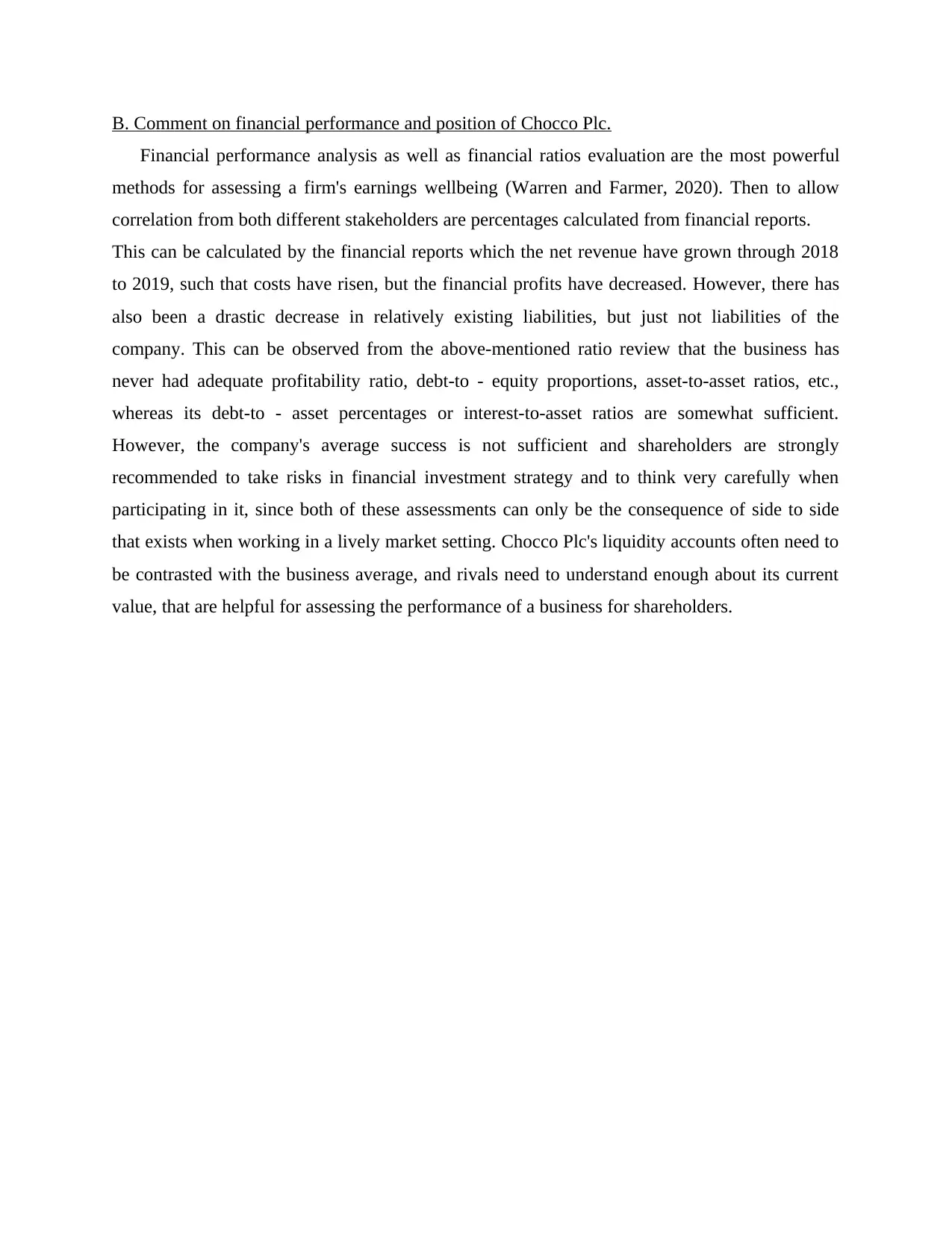
B. Comment on financial performance and position of Chocco Plc.
Financial performance analysis as well as financial ratios evaluation are the most powerful
methods for assessing a firm's earnings wellbeing (Warren and Farmer, 2020). Then to allow
correlation from both different stakeholders are percentages calculated from financial reports.
This can be calculated by the financial reports which the net revenue have grown through 2018
to 2019, such that costs have risen, but the financial profits have decreased. However, there has
also been a drastic decrease in relatively existing liabilities, but just not liabilities of the
company. This can be observed from the above-mentioned ratio review that the business has
never had adequate profitability ratio, debt-to - equity proportions, asset-to-asset ratios, etc.,
whereas its debt-to - asset percentages or interest-to-asset ratios are somewhat sufficient.
However, the company's average success is not sufficient and shareholders are strongly
recommended to take risks in financial investment strategy and to think very carefully when
participating in it, since both of these assessments can only be the consequence of side to side
that exists when working in a lively market setting. Chocco Plc's liquidity accounts often need to
be contrasted with the business average, and rivals need to understand enough about its current
value, that are helpful for assessing the performance of a business for shareholders.
Financial performance analysis as well as financial ratios evaluation are the most powerful
methods for assessing a firm's earnings wellbeing (Warren and Farmer, 2020). Then to allow
correlation from both different stakeholders are percentages calculated from financial reports.
This can be calculated by the financial reports which the net revenue have grown through 2018
to 2019, such that costs have risen, but the financial profits have decreased. However, there has
also been a drastic decrease in relatively existing liabilities, but just not liabilities of the
company. This can be observed from the above-mentioned ratio review that the business has
never had adequate profitability ratio, debt-to - equity proportions, asset-to-asset ratios, etc.,
whereas its debt-to - asset percentages or interest-to-asset ratios are somewhat sufficient.
However, the company's average success is not sufficient and shareholders are strongly
recommended to take risks in financial investment strategy and to think very carefully when
participating in it, since both of these assessments can only be the consequence of side to side
that exists when working in a lively market setting. Chocco Plc's liquidity accounts often need to
be contrasted with the business average, and rivals need to understand enough about its current
value, that are helpful for assessing the performance of a business for shareholders.
1 out of 10